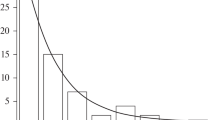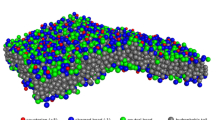Summary
Charge-pulse experiments were performed with lipid bilayer membranes from oxidized cholesterol/n-decane at relatively high voltages (several hundred mV). The membranes show an irreversible mechanical rupture if the membrane is charged to voltages on the order of 300 mV. In the case of the mechanical rupture, the voltage across the membrane needs about 50–200 μsec to decay completely to zero. At much higher voltages, applied to the membrane by charge pulses of about 500 nsec duration, a decrease of the specific resistance of the membranes by nine orders of magnitude is observed (from 108 to 0.1 Ω cm2), which is correlated with the reversible electrical breakdown of the lipid bilayer membrane. Due to the high conductance increase (breakdown) of the bilayer it is not possible to charge the membrane to a larger value than the critical potential differenceV c. For 1m alkali ion chloridesV c was about 1 V. The temperature dependence of the electrical breakdown voltageV c is comparable to that being observed with cell membranes.V c decreases between 2 and 48°C from 1.5 to 0.6 V in the presence of 1m KCl.
Breakdown experiments were also performed with lipid bilayer membranes composed of other lipids. The fast decay of the voltage (current) in the 100-nsec range after application of a charge pulse was very similar in these experiments compared with experiments with membranes made from oxidized cholesterol. However, the membranes made from other lipids show a mechanical breakdown after the electrical breakdown, whereas with one single membrane from oxidized cholesterol more than twenty reproducible breakdown experiments could be repeated without a visible disturbance of the membrane stability.
The reversible electrical breakdown of the membrane is discussed in terms of both compression of the membrane (electromechanical model) and ion movement through the membrane induced by high electric field strength (Born energy).
Similar content being viewed by others
References
Alvarez, O., Latorre, R. 1978. Voltage-dependent capacitance in lipid bilayers made from monolayers.Biophys. J. 21:1
Apell, H.-J., Bamberg, E., Alpes, H., Läuger, P. 1977. Formation of ion channels by a negatively charged analog of gramicidin A.J. Membrane Biol. 31:171
Benz, R., Fröhlich, O., Läuger, P., Montal, M. 1975. Electrical capacity of black lipid films and of lipid bilayers made from monolayers.Biochim. Biophys. Acta 394:323
Benz, R., Fröhlich, O., Läuger, P. 1976. Influence of membrane structure on the kinetics of carrier mediated ion transport through lipid bilayers.Biochim. Biophys. Acta 464:465
Benz, R., Gisin, B.F. 1978. Influence of membrane structure on ion transport through lipid bilayer membranes.J. Membrane Biol. 40:293
Benz, R., Janko, K. 1976. Voltage-induced capacitance relaxation of lipid bilayer membranes. Effect of membrane composition.Biochim. Biophys. Acta 455:721
Benz, R., Läuger, P. 1976. Kinetic analysis of carrier-mediated ion transport by the charge-pulse technique.J. Membrane Biol. 27:171
Benz, R., Läuger, P., Janko, K. 1976. Transport kinetics of hydrophobic ions in lipid bilayer membranes. Charge pulse relaxation studies.Biochim. Biophys. Acta 455:701
Benz, R., Stark, G., Janko, K., Läuger, P. 1973. Valinomycin-mediated ion transport through neutral lipid membranes: Influence of hydrocarbon chain length and temperature.J. Membrane Biol. 14:339
Boheim, G., Benz, R. 1978. Charge-pulse relaxation studies with lipid bilayer membranes modified by alamethicin.Biochim. Biophys. Acta 507:262
Coster, H.G.L., Zimmermann, U. 1975. The mechanism of electrical breakdown in the membranes ofValonia utricularis.J. Membrane Biol. 22:73
Coster, H.G.L., Zimmermann, U. 1975. Dielectric breakdown in the membranes ofValonia utricularis. The role of energy dissipation.Biochim. Biophys. Acta 382:410
Crowley, J.M. 1973. Electrical breakdown of bimolecular lipid membranes as an electromechanical instability.Biophys. J. 13:711
Feldberg, S.W., Kissel, G. 1975. Charge pulse studies of transport phenomena in bilayer membranes. I. Steady-state measurements of actin- and valinomycin-mediated transport in glycerol monooleate bilayers.J. Membrane Biol. 20:269
Feldberg, S.W., Nakadomari, H. 1977. Charge pulse studies of transport phenomena in bilayer membranes. II. Detailed theory of steady-state behavior and application to valinomycin-mediated potassium transport.J. Membrane Biol. 31:81
Haydon, D.A. 1970. A critique of the black film as a membrane model.In: Permeability and Function of Biological Membranes. L. Balis, A. Katchalsky, R.D. Keynes, W.R. Loewenstein, and B.A. Pethica, editors. p. 185. North-Holland, Amsterdam
Hodgkin, A.L., Huxley, A.F. 1952. Currents carried by sodium and potassium ions through the membrane of the giant axon ofLoligo.J. Physiol. (London) 116:449
Janko, K., Benz, R. 1977. Properties of lipid bilayer membranes made from lipids containing phytanic acid.Biochim. Biophys. Acta 470:8
Montal, M., Mueller, P. 1972. Formation of bimolecular membranes from lipid monolayers and a study of their electrical properties.Proc. Nat. Acad. Sci. USA 69:3561
Neumcke, B., Walz, D., Läuger, P. 1970. Non linear effects in lipid bilayer membranes. III. The dissociation field effect.Biophys. J. 10:172
Onsager, L. 1934. Deviations from Ohm's law in week electrolyts.J. Chem. Phys. 2:599
Parsegian, A. 1969. Energy of an ion crossing a low dielectric membrane. Solution to four relevant electro-static problems.Nature (London) 221:844
Pilwat, G., Zimmermann, U., Riemann, F. 1975. Dielectric breakdown measurements of human and bovine erythrocyte membranes using benzyl-alcohol as a probe molecule.Biochim. Biophys. Acta 406:424
Requena, J., Haydon, D.A., Hladky, S.B. 1975. Lenses and the compression of black lipid membranes by an electric field.Biophys. J. 15:77
Riemann, F., Zimmermann, U., Pilwat, G. 1975. Release and uptake of haemoglobin and ions in red blood cells induced by dielectric breakdown.Biochim. Biophys. Acta 394:449
Singleton, W.S., Gray, M.S., Brown, M.L., White, J.L. 1965. Chromatographically homogeneous lecithin from egg phospholipid.J. Am. Oil Chem. Soc. 42:53
Tien, H.T., Carbone, S., Dawidowicz, E.A. 1966. Formation of “black” lipid membranes by oxydation products of cholesterol.Nature (London) 212:718
Vienken, J., Jeltsch, E., Zimmermann, U. 1978. Penetration and entrapment of large particles in erythrocytes by electrical breakdown techniques.Cytobiology.17:182
White, S.H. 1970. Thickness changes in lipid bilayer membranes.Biochim. Biophys. Acta 196:354
White, S.H. 1972. Analysis of the torus surrounding planar lipid bilayer membranes.Biophys. J. 12:432
White, S.H. 1974. Comments on “Electrical breakdown of bimolecular lipid membranes as an electromechanical instability”.Biophys. J. 14:155
Zimmermann, U. 1973. Transportprozesse durch Biomembranen. Jahresbericht der Kernforschungsanlage, Jülich GmbH
Zimmermann, U. 1977. Organspezifische Applikation von Pharmaka über zelluläre Trägersysteme.Chem. Labor Betr. 28:505
Zimmermann, U. 1977. Cell turgor pressure regulation and turgor pressure-mediated transport processes.In: Integration of Activity in the Higher Plannt. D. Jennings, editor. p. 117. University Press, Cambridge
Zimmermann, U., Beckers, F., Coster, H.G.L. 1977. The effect of pressure on the electrical breakdown in the membranes ofValonia utricularis.Biochim. Biophys. Acta 464:399
Zimmermann, U., Beckers, F., Steudle, E. 1977. Turgor sensing in plant cells by the electromechanical properties of the membrane.In: Transmembrane Ionic Exchanges in Plants. M. Thellier, A. Monnier, M. Demarty, and J. Dainty, editors. No. 258, p. 155. C.N.R.S., Paris
Zimmermann, U., Pilwat, G. 1976. Organspezifische Applikation von pharmazeutisch aktiven Substanzen über zelluläre Trägersysteme.Z. Naturforsch. 31c:732
Zimmermann, U., Pilwat, G., Beckers, F., Riemann, F. 1976. Effects of external electrical fields on cell membranes.Bioelectrochem. Bioenerg. 3:58.
Zimmermann, U., Pilwat, G., Esser, B. 1978. The effect on encapsulation in red blood cells on the distribution of methotrexate in mice.J. Clin. Chem. Clin. Biochem. 16:135
Zimmermann, U., Pilwat, G., Holzapfel, C., Rosenheck, K. 1976. Electrical hemolysis of human and bovine red blood cells.J. Membrane Biol. 30:135
Zimmermann, U., Pilwat, G., Riemann, F. 1974. Dielectric breakdown in cell membranes.In: Membrane Transport in Plants. U. Zimmermann and J. Dainty, editors. p. 146. Springer-Verlag, Berlin-Heidelberg-New York
Zimmermann, U., Pilwat, G., Riemann, F. 1974. Dielectric breakdown in cell membranes.Biophys. J. 14:881
Zimmermann, U., Pilwat, G., Riemann, F. 1975. Preparation of erythrocyte ghosts by dielectric breakdown of the cell membrane.Biochim. Biophys. Acta 375:209
Zimmermann, U., Riemann, F., Pilwat, G. 1976. Enzyme loading of electrically homogeneous human red blood cell ghosts prepared by dielectric breakdown.Biochim. Biophys. Acta 436:460
Zimmermann, U., Schulz, J., Pilwat, G. 1973. Transcellular ion flow inE. coli B and electrical sizing of bacteria.Biophys. J. 13:1005
Author information
Authors and Affiliations
Rights and permissions
About this article
Cite this article
Benz, R., Beckers, F. & Zimmermann, U. Reversible electrical breakdown of lipid bilayer membranes: A charge-pulse relaxation study. J. Membrain Biol. 48, 181–204 (1979). https://doi.org/10.1007/BF01872858
Received:
Revised:
Issue Date:
DOI: https://doi.org/10.1007/BF01872858




